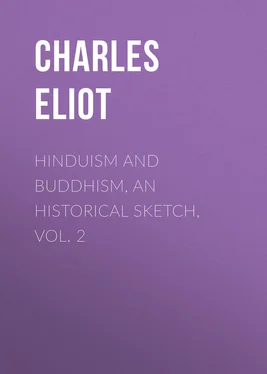Charles Eliot - Hinduism and Buddhism, An Historical Sketch, Vol. 2
Здесь есть возможность читать онлайн «Charles Eliot - Hinduism and Buddhism, An Historical Sketch, Vol. 2» — ознакомительный отрывок электронной книги совершенно бесплатно, а после прочтения отрывка купить полную версию. В некоторых случаях можно слушать аудио, скачать через торрент в формате fb2 и присутствует краткое содержание. Жанр: foreign_religion, Философия, Религиозная литература, foreign_psychology, foreign_antique, foreign_prose, на английском языке. Описание произведения, (предисловие) а так же отзывы посетителей доступны на портале библиотеки ЛибКат.
- Название:Hinduism and Buddhism, An Historical Sketch, Vol. 2
- Автор:
- Жанр:
- Год:неизвестен
- ISBN:нет данных
- Рейтинг книги:4 / 5. Голосов: 1
-
Избранное:Добавить в избранное
- Отзывы:
-
Ваша оценка:
- 80
- 1
- 2
- 3
- 4
- 5
Hinduism and Buddhism, An Historical Sketch, Vol. 2: краткое содержание, описание и аннотация
Предлагаем к чтению аннотацию, описание, краткое содержание или предисловие (зависит от того, что написал сам автор книги «Hinduism and Buddhism, An Historical Sketch, Vol. 2»). Если вы не нашли необходимую информацию о книге — напишите в комментариях, мы постараемся отыскать её.
Hinduism and Buddhism, An Historical Sketch, Vol. 2 — читать онлайн ознакомительный отрывок
Ниже представлен текст книги, разбитый по страницам. Система сохранения места последней прочитанной страницы, позволяет с удобством читать онлайн бесплатно книгу «Hinduism and Buddhism, An Historical Sketch, Vol. 2», без необходимости каждый раз заново искать на чём Вы остановились. Поставьте закладку, и сможете в любой момент перейти на страницу, на которой закончили чтение.
Интервал:
Закладка:
Here, as elsewhere, Buddhist and Brahmanic ideas acted and reacted in such complex interrelations that it is hard to say which has borrowed from the other. As to dates, the older Upanishads which contain the foundations but not the complete edifice of Vedantism, seem a little earlier than the Buddha. Now we know that within the Vedantist school there were divergences of opinion which later received classic expression in the hands of Śankara and Râmânuja. The latter rejected the doctrines of Mâyâ and of the difference between relative and absolute truth. The germs of both schools are to be found in the Upanishads but it seems probable that the ideas of Śankara were originally worked out among Buddhists rather than among Brahmans and were rightly described by their opponents as disguised Buddhism. As early as 520 A.D. Bodhidharma preached in China a doctrine which is practically the same as the Advaita.
The earliest known work in which the theory of Mâyâ and the Advaita philosophy are clearly formulated is the metrical treatise known as the Kârikâ of Gauḍapâda. This name was borne by the teacher of Śankara's teacher, who must have lived about 700 A.D., but the high position accorded to the work, which is usually printed with the Mâṇḍûkya Upanishad and is practically regarded as 185 185 Or as itself forming four separate Upanishads. For other arguments in favour of an early date see Walleser, Älterer Vedânta , pp. 14 ff. He states that the Kârikâ is quoted in the Tibetan translations of Bhavaviveka's Tārkajvālā . Bhavaviveka was certainly anterior to the travels of Hsüan Chuang and perhaps was much earlier. But if he died about 600 A.D. a work quoted by him can hardly have been later than 550 and may be much earlier. But see also Jacobi in J.A.O.S. April, 1913, p. 51.
a part of it, make an earlier date probable. Both in language and thought it bears a striking resemblance to Buddhist writings of the Mâdhyamika school and also contains many ideas and similes which reappear in the works of Śankara. 186 186 For the resemblances to Nâgârjuna see J.R.A.S. 1910, pp. 136 ff. Especially remarkable are II. 32 na nirodho na cotpattir, etc., and IV. 59 and the whole argument that causation is impossible. Noticeable too is the use of Buddhist terms like upâya, nirvâṇa, buddha and âdibuddha, though not always in the Buddhist sense.
On the other hand the Lankâvatâra Sûtra which was translated into Chinese in 513 and therefore can hardly have been composed later than 450, is conscious that its doctrines resemble Brahmanic philosophy, for an interlocutor objects that the language used in it by the Buddha about the Tathâgatagarbha is very like the Brahmanic doctrine of the Âtman. To which the Buddha replies that his language is a concession to those who cannot stomach the doctrine of the negation of reality in all its austerity. Some of the best known verses of Gauḍapâda compare the world of appearance to the apparent circle of fire produced by whirling a lighted torch. This striking image occurs first in the Maitrâyana Upanishad (VI. 24), which shows other indications of an acquaintance with Buddhism, and also in the Lankâvatâra Sûtra.
A real affinity unites the doctrine of Śankara to the teaching of Gotama himself. That teaching as presented in the Pali Pitakas is marked by its negative and deliberately circumscribed character. Its rule is silence when strict accuracy of expression is impossible, whereas later philosophy does not shrink from phrases which are suggestive, if not exact. Gotama refuses to admit that the human soul is a fixed entity or Âtman, but he does not condemn (though he also does not discuss) the idea that the whole world of change and becoming, including human souls, is the expression or disguise of some one ineffable principle. He teaches too that the human mind can grow until it develops new faculties and powers and becomes the Buddha mind, which sees the whole chain of births, the order of the world, and the reality of emancipation. As the object of the whole system is practical, Nirvana is always regarded as a terminus ad quem or an escape (nissaranam) from this transitory world, and this view is more accurate as well as more edifying than the view which treats Brahman or Śûnyatâ as the origin of the universe. When the Vedanta teaches that this changing troubled world is merely the disguise of that unchanging and untroubled state into which saints can pass, it is, I believe, following Gotama's thought, but giving it an expression which he would have considered imperfect.
CHAPTER XXII
FROM KANISHKA TO VASUBANDHU
Tradition, as mentioned above, connects the rise of the Mahayana with the reign of Kanishka. Materials for forming a picture of Indian life under his rule are not plentiful but it was clearly an age of fusion. His hereditary dominions were ample and he had no need to spend his reign in conquests, but he probably subdued Kashmir as well as Khotan, Yarkand and Kashgar. 187 187 The uncertainty as to the date of Kanishka naturally makes it uncertain whether he was the hero of these conquests. Kashmir was certainly included in the dominions of the Kushans and was a favourite residence of Kanishka. About 90 A.D. a Kushan king attacked Central Asia but was repulsed by the Chinese general Pan-Ch'ao. Later, after the death of Pan-Ch'ao (perhaps about 103 A.D.), he renewed the attempt and conquered Kashgar, Yarkand and Khotan. See Vincent Smith, Early History of India , 3rd ed. pp. 253 ff.
Hostages from one of these states were sent to reside in India and all accounts agree that they were treated with generosity and that their sojourn improved the relations of Kanishka with the northern tribes. His capital was Purushapura or Peshawar, and the locality, like many other features of his reign, indicates a tendency to amalgamate India with Persia and Central Asia. It was embellished with masterpieces of Gandharan sculpture and its chief ornament was a great stûpa built by the king for the reception of the relics of the Buddha which he collected. This building is described by several Chinese pilgrims 188 188 See Fa-Hsien, ed. Legge, p. 33, B.E.F.E.O. 1903 (Sung Yün), pp. 420 ff. Watters, Yüan Chwang , I. pp. 204 ff. J.R.A.S. 1909, p. 1056, 1912, p. 114. For the general structure of these stûpas see Foucher, L'art Gréco-Bouddhique du Gandhara , pp. 45 ff.
and its proportions, though variously stated, were sufficient to render it celebrated in all the Buddhist world. It is said to have been several times burnt, and rebuilt, but so solid a structure can hardly have been totally destroyed by fire and the greater part of the monument discovered in 1908 probably dates from the time of Kanishka. The base is a square measuring 285 feet on each side, with massive towers at the corners, and on each of the four faces projections bearing staircases. The sides were ornamented with stucco figures of the Buddha and according to the Chinese pilgrims the super-structure was crowned with an iron pillar on which were set twenty-five gilded disks. Inside was found a metal casket, still containing the sacred bones, and bearing an inscription which presents two points of great interest. Firstly it mentions "Agiśala the overseer of works at Kanishka's vihâra," that is, probably Agesilaus, a foreigner in the king's service. Secondly it states that the casket was made "for the acceptance of the teachers of the Sarvâstivâdin sect," 189 189 J.R.A.S. 1909, p. 1058. "Acaryanam Sarvastivadinam pratigrahẽ."
and the idea that Kanishka was the special patron of the Mahayana must be reconsidered in the light of this statement.
Legends ascribe Kanishka's fervour for the Buddhist faith not to education but to conversion. His coinage, of which abundant specimens have been preserved, confirms this for it presents images of Greek, Persian, Indian and perhaps Babylonian deities showing how varied was the mythology which may have mingled with Gandharan Buddhism. The coins bearing figures of the Buddha are not numerous and, as he undoubtedly left behind him the reputation of a pious Buddhist, it is probable that they were struck late in his reign and represent his last religious phase. 190 190 Similarly Harsha became a Buddhist late in life.
Hsüan Chuang 191 191 Watters, vol. I. p. 203. He places Kanishka's accession 400 years after the death of the Buddha, which is one of the arguments for supposing Kanishka to have reigned about 50 B.C., but in another passage (Watters, I. 222, 224) he appears to place it 500 years after the death.
repeats some legends which relate that he was originally anti-Buddhist, and that after his conversion he summoned a council and built a stupa.
Интервал:
Закладка:
Похожие книги на «Hinduism and Buddhism, An Historical Sketch, Vol. 2»
Представляем Вашему вниманию похожие книги на «Hinduism and Buddhism, An Historical Sketch, Vol. 2» списком для выбора. Мы отобрали схожую по названию и смыслу литературу в надежде предоставить читателям больше вариантов отыскать новые, интересные, ещё непрочитанные произведения.
Обсуждение, отзывы о книге «Hinduism and Buddhism, An Historical Sketch, Vol. 2» и просто собственные мнения читателей. Оставьте ваши комментарии, напишите, что Вы думаете о произведении, его смысле или главных героях. Укажите что конкретно понравилось, а что нет, и почему Вы так считаете.












